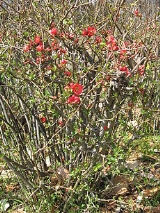
Chaenomeles speciosa
Encyclopedia
Chaenomeles speciosa (commonly known as flowering quince or Japanese quince or as mugua in traditional Chinese medicine
) is a thorny deciduous or semi-evergreen shrub native to eastern Asia
. It is taller than another commonly cultivated species, C. japonica
, usually growing to about 2 m. The flowers are usually red, but may be white or pink, and the fruit is a fragrant but hard pome
that resembles a quince
.
(TCM) for thousands of years, used to treat arthritis
, leg edema
, and cramping in the calf muscle.
and selective
dopamine reuptake inhibitor
.
Traditional Chinese medicine
Traditional Chinese Medicine refers to a broad range of medicine practices sharing common theoretical concepts which have been developed in China and are based on a tradition of more than 2,000 years, including various forms of herbal medicine, acupuncture, massage , exercise , and dietary therapy...
) is a thorny deciduous or semi-evergreen shrub native to eastern Asia
Asia
Asia is the world's largest and most populous continent, located primarily in the eastern and northern hemispheres. It covers 8.7% of the Earth's total surface area and with approximately 3.879 billion people, it hosts 60% of the world's current human population...
. It is taller than another commonly cultivated species, C. japonica
Chaenomeles japonica
Chaenomeles japonica is a species of Japanese Quince. It is a thorny deciduous shrub that is commonly cultivated. It is shorter than another commonly cultivated species C. speciosa, growing to only about 1 m in height. The fruit is called in Japanese. It is best known for its colorful spring...
, usually growing to about 2 m. The flowers are usually red, but may be white or pink, and the fruit is a fragrant but hard pome
Pome
In botany, a pome is a type of fruit produced by flowering plants in the subfamily Maloideae of the family Rosaceae.A pome is an accessory fruit composed of one or more carpels surrounded by accessory tissue...
that resembles a quince
Quince
The quince , or Cydonia oblonga, is the sole member of the genus Cydonia and native to warm-temperate southwest Asia in the Caucasus region...
.
Ethnomedical uses
The fruit has been part of traditional Chinese medicineTraditional Chinese medicine
Traditional Chinese Medicine refers to a broad range of medicine practices sharing common theoretical concepts which have been developed in China and are based on a tradition of more than 2,000 years, including various forms of herbal medicine, acupuncture, massage , exercise , and dietary therapy...
(TCM) for thousands of years, used to treat arthritis
Arthritis
Arthritis is a form of joint disorder that involves inflammation of one or more joints....
, leg edema
Edema
Edema or oedema ; both words from the Greek , oídēma "swelling"), formerly known as dropsy or hydropsy, is an abnormal accumulation of fluid beneath the skin or in one or more cavities of the body that produces swelling...
, and cramping in the calf muscle.
Pharmacology
It has been found to be an effectivePotency (pharmacology)
In the field of pharmacology, potency is a measure of drug activity expressed in terms of the amount required to produce an effect of given intensity. A highly potent drug evokes a larger response at low concentrations, while a drug of lower potency evokes a small response at low concentrations...
and selective
Functional Selectivity
Functional selectivity is the ligand-dependent selectivity for certain signal transduction pathways in one and the same receptor. This can be present when a receptor has several possible signal transduction pathways...
dopamine reuptake inhibitor
Dopamine reuptake inhibitor
A dopamine reuptake inhibitor is a type of drug that acts as a reuptake inhibitor for the neurotransmitter dopamine by blocking the action of the dopamine transporter...
.
See also
- PseudocydoniaPseudocydoniaPseudocydonia sinensis , the only species in the genus Pseudocydonia, is a deciduous or semi-evergreen tree in the family Rosaceae, native to eastern Asia in China. It is closely related to the east Asian genus Chaenomeles, and is sometimes placed in Chaenomeles as C...
(Chaenomeles sinensis), also called mugua - PapayaPapayaThe papaya , papaw, or pawpaw is the fruit of the plant Carica papaya, the sole species in the genus Carica of the plant family Caricaceae...
, a tropical fruit that shares the name mugua

